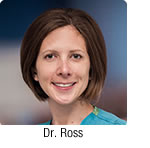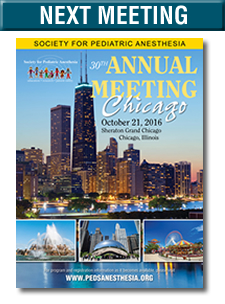Pediatric anesthesiology 2016 reviews
Friday Session IV: Cardiac Refresher “The Rhythm is Gonna Get You”
 Reviewed by Faith J. Ross, MD
Reviewed by Faith J. Ross, MD
Seattle Children’s Hospital, Seattle
Suanne Daves, MD (Monroe Carell Children’s Hospital at Vanderbilt, Nashville) moderated an excellent review of cardiac electrophysiology and extracorporeal membrane circulation (ECMO).
Richard Ing, MBBCh (Children’s Hospital Colorado, Aurora) began the session with an informative discussion of long QT syndrome (LQTS). Cardiac channelopathies such as LQTS are responsible for 10-35% of sudden unexplained cardiac deaths. Acquired or genetic alterations in cardiac ion channels cause changes in electrical activity that can lead to a variety of channelopathies, including long QTS, short QTS, Brugada Syndrome, and others.
In the normal heart, rapid inflow of Na and Ca ions causes depolarization of cardiac cells followed by repolarization as K ions flow out of the cell. In LQTS, altered ion channel function results in a delay of ventricular repolarization, which manifests as a long QT interval on ECG. Delayed repolarization leaves the myocardium sensitive to early after depolarizations and consequent arrhythmias. A normal QT interval is 350-450 ms in males and 360-460 in females. QT interval greater than 500 ms is associated with torsade de pointes. LQTS may be associated with other anomalies, such as syndactyly in Timothy Syndrome, and congenital deafness in Jervell and Lange-Nielson Syndrome.
Many commonly used perioperative medications can increase the QT interval, provoking arrhythmias in patients with LQTS. Medications associated with prolonged QT interval include various antiarrhythmic agents, droperidol, ondansetron, phenylephrine, and ketamine. Sevoflurane and other volatile anesthetics also have an effect on QT interval and should be used cautiously. (A more complete and updated list of medications that impact the QT interval can be found at crediblemeds.org.) Patients with LQTS should be maintained on beta-blockers and kept calm and comfortable to avoid catecholamine surges in the perioperative period. Electrolytes should be maintained within normal levels.
Brugada syndrome, another cardiac channelopathy, is associated with RV conduction delay that may be unmasked by fever and often manifests as sudden death during sleep. Interestingly, the impact of medications in Brugada syndrome is quite different than in LQTS. Sevoflurane is likely safe in this condition; however, propofol should be used with care. Dexmedetomidine, neostigmine, metoclopramide, and local anesthetics predispose to arrhythmias in these patients. (A more complete account of medication safety in Brugada Syndrome can be found at Brugadadrugs.org.)
In the future, it is likely that more sophisticated electrocardiographic screening utilizing transmural dispersion measurement and microvolt T wave alternans will allow early identification of patients with channelopathies and facilitate primary prevention of arrhythmias. Dr. Ing ended the presentation with a fascinating report of a novel mobile AED drone that travels to the site of need via a cellphone GPS signal. More conventional projects to place AEDs in schools and other public locations are also crucial in assuring safety and limiting preventable mortality in patients with channelopathies.
Manchula Navaratnam, MD (Lucille Packard Children’s Hospital, Palo Alto) continued the session with a review of Pacemakers and AICDs. Since the development of the first pacemaker in the late 1950s, cardiovascular implantable electronic device (CIED) technology has rapidly expanded and CIEDs are now commonly used in both adults and children. In children, pacemakers are indicated for symptomatic bradycardia and congenital or acquired AV node block. AICDs were originally placed only for secondary prevention of lethal arrhythmias, but are now used for primary prevention as well. Cardiac resynchronization therapy with biventricular pacing can improve mechanical efficiency in hearts with dysynchronous ventricular contraction. Transvenous or epicardial placement may be used depending on patient size and access. Transvenous pacemakers are typically used in children over 15 kg and are implanted percutaneously by an electrophysiologist. They are less prone to lead fracture than epicardial pacemakers and have a lower pacing threshold, which contributes to a longer batter life.
Dr. Navaratnam reviewed pacer nomenclature with an emphasis on the changes in device functions as technology has progressed. The first pacemakers were VOO only (asynchronous ventricular pacing). Pacemakers today can sense and pace, modulate rate with physical activity, and provide antitachycardia pacing and defibrillation to combat tachyarrhythmias.
Physicians caring for patients with CIEDs should be aware of several important issues that impact anesthetic care. Electromagnetic interference (EMI) from electrocautery or other sources can adversely affect the function of CIEDs, causing inappropriate triggering or inhibition of pacing or inappropriate shock. Induction of current in the leads can cause electrical damage to the device leads and to the myocardium. Damage or fracture of the leads can cause changes in the pacing threshold and loss of electrical capture. If electrocautery is used, the grounding pad should be placed remote from the device and the surgeon should use low energy, short cautery bursts as possible. Bipolar cautery reduces the risk of device interference and should be considered when surgical plan allows.
As revealed in the audience poll, the effect of magnets on CIEDs is a source of confusion for many anesthesiologists. The impact of a magnet on a CIED depends on the manufacturer and the type of the device. In general, a magnet will change a pacemaker to asynchronous pacing at a preset rate. For a device with ICD and pacing functions, a magnet will suspend the ICD function but will not convert the pacemaker to an asynchronous mode. Magnets should be used with caution, particularly in children, as the preset rate may not be adequate for all patients.
Preoperative evaluation includes a thorough history and physical, focusing on the indication for the CIED, the underlying rhythm, the generator location, manufacturer, and any coexisting cardiac pathology. Anesthesiologists should review a 12 lead ECG and the results of the most recent device interrogation. CXR demonstrates lead number and integrity. When EMI is planned, pacemakers should be reprogrammed to an asynchronous rate greater than the patient’s native rate and rate responsiveness should be disabled. Alternative methods of pacing and defibrillation should be available whenever a device is inactivated or reprogrammed. It is important to maintain normal electrolyte levels, as severe electrolyte abnormalities can alter pacing threshold and electrical capture. Devices that have been inactivated or reprogrammed should be reevaluated and reprogrammed postoperatively. Dr. Navaratnam presented several useful algorithms for perioperative planning and intraoperative trouble-shooting of CIEDs.
Todd Kilbaugh, MD (Children’s Hospital of Philadelphia) concluded the cardiac refresher session with a fascinating look at the future of ECMO. In the early 1990s, ECMO was used primarily for respiratory support in neonates with respiratory failure. In the past two decades, indications for ECMO have dramatically expanded to include various causes of adult and pediatric cardiac and respiratory failure. With improvement in oxygenator technology and transition from roller pumps to centrifugal pumps, the hemolytic and inflammatory response to ECMO has been reduced, allowing safer use in a wider variety of patients. In the neonatal ICU (NICU), ECMO is often used for meconium aspiration, or less commonly, congenital diaphragmatic hernia, sepsis, or pneumonia. In congenital heart disease, ECMO is used for failure to separate from cardiopulmonary bypass, as a bridge to recovery or transplantation for low cardiac output, and resuscitation from sudden cardiac arrest (ECPR). ECMO is now being used for support in conditions that were previously thought to be contraindications such as cancer and sepsis.
Reports suggest promising results for ECMO in a variety of clinical situations. A randomized trial of neonatal ECMO in the UK showed improved patient outcomes at 1, 4, and 7 years with introduction of an ECMO policy. The CESAR trial evaluated 180 adult patients with severe respiratory failure randomized to ECMO vs. conventional ventilation. Patients who received ECMO had a reduced risk of severe disability and a trend toward decreased mortality. The ELSO database of patients from 2005-2012 showed that prolonged duration of mechanical ventilation before ECMO was associated with lower survival and mortality increased steadily after 15 days of ECMO. Based on this data, CHOP has modified the treatment strategy for patients with severe respiratory failure to include early use of ECMO, daily lung recruitment, and bronchoscopy guided by an anesthesiologist-led care team. Institution of this strategy was associated with an increase in survival rate from 50% to over 80%.
In the future, neurologic recovery after cardiac arrest may be improved with medications that alter metabolic rate and improve mitochondrial function. Deployment of mobile ECMO cannulation units and portable ECMO pumps will facilitate early cannulation and extend the geographic availability of this technology.
Anesthesiologists have a crucial role to play in the development and expansion of ECMO in the coming years.





